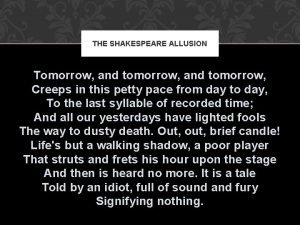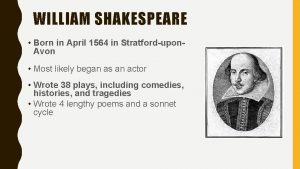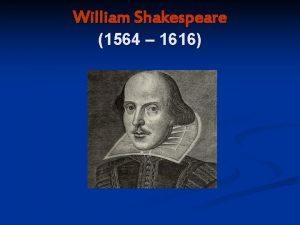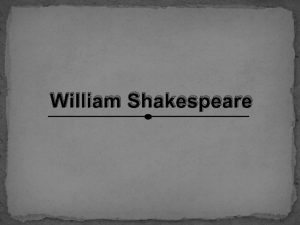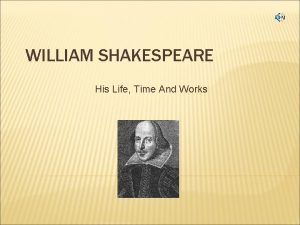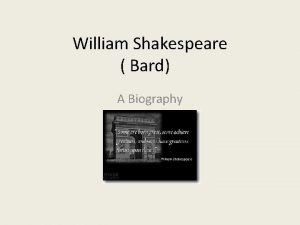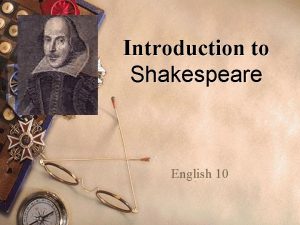William Shakespeare All the worlds a stage And































- Slides: 31

William Shakespeare All the world's a stage, And all the men and women merely players; They have their exits and their entrances, And one man in his time plays many parts… Shakespeare, As You Like It

The baptismal register of the Holy Trinity parish church, in Stratford, shows the following entry for April 26, 1564: Gulielmus filius Johannes Shakespeare. The actual date of Shakespeare's birth is not known, but, traditionally, April 23, St George's Day, has been Shakespeare's accepted birthday, and a house on Henley Street in Stratford, owned by William's father, John, is accepted as Shakespeare's birth place. However, the reality is that no one really knows when he was born. According to The Book of Common Prayer, it was required that a child be baptized on the nearest Sunday or holy day following the birth

Shakespeare’s education �Shakespeare probably began his education at the age of six or seven at the Stratford grammar school, which is still standing only a short distance from his house on Henley Street. Although we have no record of Shakespeare attending the school, due to the official position held by John Shakespeare it seems likely that he would have decided to educate William at the school which was under the care of Stratford's governing body.

The Classics �As was the case in all Elizabethan grammar schools, Latin was the primary language of learning. The study of Latin authors like Seneca, Cicero, Ovid, Virgil, and Horace would have been the focus of Shakespeare’s literary training. Shakespeare absorbed much that was taught in his grammar school, for, as we can see from his works, he had an impressive familiarity with the stories by classical authors.

The “Lost” Years: 1578 -82 and 1585 -92 �Shakespeare was removed from school around age thirteen because of his father's financial and social difficulties. Yet, there is no reason to believe that he had not acquired a good knowledge of both English and Latin. Shakespeare's activities after he left school and before he re-emerged as a professional actor in the late 1580 s are impossible to trace. But, it is from this period known as the “lost years, ” that we obtain one vital piece of information about Shakespeare: in 1582 he married a pregnant orphan named Anne Hathaway.

Shakespeare’s marriage and children � Recordings in the Episcopal register at Worcester on the dates of November 27 and 28, 1582, reveal that Shakespeare minor at the time, married Anne Hathaway, who was twenty-six and already several months pregnant. Anne was the eldest daughter of Richard Hathaway. The couple’s first child was Susanna, christened on May 26 th, 1583, and twins arrived in January, 1585. They were baptized on February 2 of that year and named after two friends -- the baker Hamnet Sadler and his wife, Judith. Not much information is known about the life of Anne and her children after this date, except for the tragic fact that Hamnet Shakespeare died of an unknown cause on August 11, 1596, at the age of eleven.

Elizabethan Theatre �Around 1576 the first commercial theatre was built in England: in James Burbage’s Theatre, for the first time, audiences paid money to see plays performed in a permanent playhouse. Within a few years an entire institution had sprung up, comprising rival companies and playwrights, theatre owners and managers, actors and hired hands. The Globe Theatre in the foreground of Claes Visscher’s panorama of London, 1616

�At the same time, the Philip Stubbes rails against ‘stage plays and their wickedness’ in his Anatomie of Abuses, 1583 theatre was an object of suspicion: were the actors usurping the parts of their betters by dressing up as kings and courtiers? Was theatre responsible for spreading sedition and encouraging immoral behaviour? Such questions testify both to the popularity of theatres and the dangers posed by that popularity

Shakespeare the Actor � We don’t know why Shakespeare decided to go from Stratford to London to become an actor but we do know that he began his career on the stage by 1592, because there is reference to this by another writer, Robert Greene. In 1594, he became a leading member of the Lord Chamberlain's Men and even performed before the Queen. � The reputation of actors was not good in that period. Actors were treated with suspicion as rogues and liars by those against theatre. Acting Troupes were considered such a threat that regulations were imposed and licenses were granted to the aristocracy for the maintenance of troupes of players.

�Plays were subject to censorship - the content of plays was checked to ensure that they did not contain political or religious elements which might threaten the state. �There were no women actors in theatres. Young boys or young men would play the female roles. �Shakespeare soon moved on to becoming theatre owner and playwright. He was more completely and more continuously involved in theatres and acting companies than any other Elizabethan dramatist. a young dandy called Nim shows off his new suit of clothes at theatre

ELIZABETHAN PLAYHOUSES The Swan Theatre, London in 1596, drawing by a Dutch traveller In 1578 six companies were granted permission by special order of the queen to perform plays. They were the Children of the Chapel Royal, Children of Saint Paul's, the Servants of the Lord Chamberlain, Servants of Lords Warwick, Leicester, and Essex. The building of the playhouses outside the city had already begun in 1576.

A new form of popular entertainment �At the end of the reign of Elizabeth there were eleven theaters in London, including public and private houses. Various members of the royal family were the patrons of the new companies. �The plays were the property, not of the author, but of the acting companies. Aside from the costly costumes, they formed the most valuable part of the company's capital. The parts were learned by the actors, and the manuscript locked up. If the piece became popular, rival managers often stole it by sending to the performance a clerk who took down the lines in shorthand.

�In Shakespeare's time, a stage wasn't just one type of space; plays had to be versatile. The same play might be produced in an outdoor playhouse, an indoor theater, a royal palace—or, for a company on tour, the courtyard of an inn. �The stage itself was relatively bare. For the most part, playwrights used vivid words instead of scenery to picture the scene onstage. In addition to their dramatic talents, actors in Shakespeare's time had to fence onstage with great skill, sing songs or play instruments included in the plays, and perform the athletic dances of their day.

Actors �Audiences had their favorite performers, looked forward to hearing music with the productions, and relished the luxurious costumes of the leading characters. �Actors usually did not aim for historically accurate costumes. Instead, they typically wore gorgeous modern dress, especially for the leading parts. Costumes, a major investment for an acting company, provided the essential spectacle of the plays and were often second-hand clothes once owned and worn by real-life nobles.

The Earl of Southampton (1573– Photograph of Michael Brown as 1624) was well-known for his Viola/Cesario and Rhys Meredith showy, expensive clothes. In this as Sebastian in Shakespeare's painting, he wears a silk doublet, Globe production of Twelfth hose, coloured garters and Night, 2002 embroidered gloves.

Shakespeare as Emerging Playwright �Records tell us that several of Shakespeare's plays were popular by the early 1590 s, including Henry VI, The Comedy of Errors, and Titus Andronicus. The company that staged most of the early productions of these plays was Pembroke's Men, sponsored by the Earl of Pembroke, Henry Herbert. The troupe was very popular and performed regularly at the court of Queen Elizabeth. Most critics conclude that Shakespeare spent time as both a writer and an actor for Pembroke's Men before 1592.

& Theatre Owner �In 1594, he became a leading member of the Lord Chamberlain's Men, formally known as Lord Strange's Men. He not only wrote plays for his company, acted in the plays, and shared the profits, but who was also one of the housekeepers who owned the building. For seventeen years he was one of the owners of the Globe theatre and for eight years he was one of the housekeepers of the company's second theatre, the Blackfriars, as well.

The Globe Theatre in London

The King’s Men �Blackfriars Theatre was built by Richard Burbage in 1596 on the northern bank of the Thames. Unlike the public theatres, private theatres like the Blackfriars had roofs and catered to the wealthy classes of London society. The Blackfriars soon became the premier playhouse in all of London. The price for admission was up to five times that of the Globe, and it seated about 700 people. The Sam Wanamaker playhouse – a new candlelit theatre next to Shakespeare’s Globe – is designed to replicate the indoor playhouses of the early 17 th century

�In 1603, when James I acceded to the English throne, the Chamberlain's Men's patron, Lord Hudson, stepped down and allowed James I, a lover of theatre, to become the group's new supporter. Hence, the Chamberlain's Men quickly underwent a name change and were known thenceforth as the King's Men. �Shakespeare's last appearance on the stage was in late 1603.

Shakespeare’s Reputation � Mere’s eulogy, 1598. �Of the many testimonies paid to Shakespeare’s literary reputation at this period of his career, the most striking was that of Francis Meres was a learned graduate of Cambridge University, who brought out in 1598 a collection of sayings on morals, religion, and literature which he entitled ‘Palladis Tamia. ’ In the book he also surveyed contemporary literary effort in England. �Shakespeare figured in Meres’s pages as the greatest man of letters of the day. ‘The Muses would speak Shakespeare’s fine filed phrase, ’ Meres asserted, ‘if they could speak English. ’ ‘Among the English, ’ he declared, ‘he was the most excellent in both kinds for the stage’

The Plays �The general consensus is that Shakespeare wrote thirty-seven plays. However, no one can know for certain because of the inexact documentation at the time the plays were first being organized and published. Recently critics have begun to reassess a play called Edward III, and another play, Sir Thomas More. Handwriting analysis has led scholars to believe that Shakespeare revised parts of Sir Thomas More, but, like Edward III, it is not part of the standard collection of Shakespeare's plays.

The Book of Sir Thomas More: Shakespeare's only surviving literary manuscript Part of the only surviving play-script to contain Shakespeare’s handwriting: the play was written by other authors, and in 1603 Shakespeare added a scene in which More prevents a crowd from rioting against immigrants.

� Comedies All's Well That Ends Well, As You Like It, Cymbeline, The Comedy of Errors, Love's Labour's Lost, Measure for Measure, The Merchant of Venice, The Merry Wives of Windsor, A Midsummer Night's Dream, Much Ado About Nothing, Pericles, The Taming of the Shrew, The Tempest, Troilus and Cressida, The Two Gentlemen of Verona, Twelfth Night, The Winter's Tale � Tragedies Antony and Cleopatra, Coriolanus, Hamlet, Julius Caesar, King Lear, Macbeth, Othello, Romeo and Juliet, Timon of Athens, Titus Andronicus Histories 1, 2, and 3 Henry VI, 1 and 2 Henry IV, King John, Henry VIII, Richard III

Publishing the Plays Shakespeare's Quartos �Before the publication of the First Folio in 1623, nineteen of the thirty-seven plays in Shakespeare's canon had appeared in quarto format, published prior to Shakespeare's retirement from theatre in about 1611. It is unlikely that Shakespeare was involved directly with the printing of any of his plays. The plays printed originally in quarto format were branded fake by the editors of the First Folio, Heminge and Condell. They believed that most of the quartos in circulation had been either stolen outright by printers who plagiarized the official prompt-books belonging to the company or they had been reconstructed from the memory of actors. Early scholars believed that the First Folio was the only authoritative Shakespearean manuscript, and that all of the quartos were poor texts.

Shakespeare’s First Folio at the British Library

The Folio � In the early 20 th century, scholars began to challenge the claims made by the editors of the First Folio and reassess the validity of the quartos. It is now believed that only ten of the quartos are corrupt or unauthorized. � Heminge and Condell had been Shakespeare's fellow actors in the Chamberlain's Men (later the King's Men). They intended, as outlined in the Preface to the First Folio, to compile Shakespeare's work “without ambition either of self-profit or fame, only to keep the memory of so worthy a friend and fellow alive as was our Shakespeare. . ” They included thirty-six plays in the First Folio under the headings Comedies, Histories, and Tragedies

�Quarto - A quarto is a book in which eight pages are printed on a single sheet which is folded twice to form four leaves. The average quarto contains about one hundred pages, and is about 6 3/4 x 8 1/2 inches in size. Folio - A folio is a book in which each sheet is folded over only once through the middle, forming two leaves (or four pages). The First Folio has 454 leaves, approximately 8 1/2 x 13 3/8 inches in size.

1594 quarto of Titus Andronicus Many of the earliest of the quartos, like Titus Andronicus, shown here, do not include Shakespeare's name but highlight instead the acting company that first performed the play. During his lifetime, about half of Shakespeare's plays were printed as one-play quartos.

Shakespeare’s Death �Shakespeare's death at the age of fifty-two will almost surely remain a mystery. An entry in the diary of John Ward, the vicar of Holy Trinity Church in Stratford, tells us that “Shakespeare, Drayton, and Ben Jonson had a merry meeting and it seems drank too hard, for Shakespeare died of a fever there contracted. ” Ward, a self-proclaimed Shakespeare fan, wrote his diary fifty years after Shakespeare died and most historians agree it appears to be a baseless anecdote. It should be noted though that a serious outbreak of typhus, known as the new fever, in 1616 (the year Shakespeare died), lends credibility to Ward's story.

�Shakespeare is buried in the chancel of Holy Trinity Church in his hometown of Stratford, Warwickshire. His gravestone bears an epitaph which Shakespeare himself supposedly wrote. It warns: �Good friend for Jesus sake forbeare, To dig the dust enclosed here. Blessed be the man that spares these stones, And cursed be he that moves my bones.
 All the worlds a stage
All the worlds a stage All worlds a stage
All worlds a stage Slides
Slides Kurt vonnegut tomorrow and tomorrow and tomorrow
Kurt vonnegut tomorrow and tomorrow and tomorrow When was shakespeare born
When was shakespeare born Shakespeare careers
Shakespeare careers When was william shakespeare born and died
When was william shakespeare born and died William shakespeare’s ‘romeo and juliet’ is a ______.
William shakespeare’s ‘romeo and juliet’ is a ______. The tragedy of romeo and juliet by william shakespeare
The tragedy of romeo and juliet by william shakespeare Life and times of shakespeare
Life and times of shakespeare The tragedy of romeo and juliet
The tragedy of romeo and juliet Who wrote romeo and juliet
Who wrote romeo and juliet Rabindranath tagore and shakespeare
Rabindranath tagore and shakespeare Facts about romeo
Facts about romeo J5l-production oy
J5l-production oy Draw three noncollinear points j k and l
Draw three noncollinear points j k and l Shakespeare was born
Shakespeare was born William shakespeare webquest answers
William shakespeare webquest answers Who is called the bard
Who is called the bard 1564 to 1616 england timeline
1564 to 1616 england timeline Who is shakespeare
Who is shakespeare William shakespeare pictures
William shakespeare pictures Anja pintar
Anja pintar Fun facts about william shakespeare
Fun facts about william shakespeare William shakespeare poem on nature
William shakespeare poem on nature William shakespeare childhood
William shakespeare childhood Julius caesar portia
Julius caesar portia William shakespeare was born in
William shakespeare was born in Shakespeare education school
Shakespeare education school Shakespeare, aka the bard of
Shakespeare, aka the bard of Shakespeare 23 april
Shakespeare 23 april William shakespeare 1564 to 1616
William shakespeare 1564 to 1616



